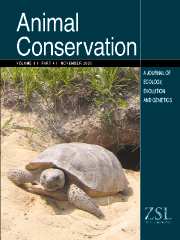Crossref Citations
This article has been cited by the following publications. This list is generated based on data provided by
Crossref.
O'Connor, T. P.
2007.
Wild or domestic? Biometric variation in the cat Felis silvestris Schreber.
International Journal of Osteoarchaeology,
Vol. 17,
Issue. 6,
p.
581.
Searle, Jeremy B.
2008.
The genetics of mammalian invasions: a review.
Wildlife Research,
Vol. 35,
Issue. 3,
p.
185.
Krüger, Matthias
Hertwig, Stefan T.
Jetschke, Gottfried
and
Fischer, Martin S.
2009.
Evaluation of anatomical characters and the question of hybridization with domestic cats in the wildcat population of Thuringia, Germany.
Journal of Zoological Systematics and Evolutionary Research,
Vol. 47,
Issue. 3,
p.
268.
Hertwig, S. T.
Schweizer, M.
Stepanow, S.
Jungnickel, A.
Böhle, U.-R.
and
Fischer, M. S.
2009.
Regionally high rates of hybridization and introgression in German wildcat populations (Felis silvestris, Carnivora, Felidae).
Journal of Zoological Systematics and Evolutionary Research,
Vol. 47,
Issue. 3,
p.
283.
O’Brien, John
Devillard, Sébastien
Say, Ludovic
Vanthomme, Hadrien
Léger, Francois
Ruette, Sandrine
and
Pontier, Dominique
2009.
Preserving genetic integrity in a hybridising world: are European Wildcats (Felis silvestris silvestris) in eastern France distinct from sympatric feral domestic cats?.
Biodiversity and Conservation,
Vol. 18,
Issue. 9,
p.
2351.
Sarmento, Pedro
Cruz, Joana
Eira, Catarina
and
Fonseca, Carlos
2009.
Spatial colonization by feral domestic catsFelis catus of former wildcatFelis silvestris silvestris home ranges.
Mammal Research,
Vol. 54,
Issue. 1,
p.
31.
Jerosch, Saskia
Götz, Malte
Klar, Nina
and
Roth, Mechthild
2010.
Characteristics of diurnal resting sites of the endangered European wildcat (Felis silvestris silvestris): Implications for its conservation.
Journal for Nature Conservation,
Vol. 18,
Issue. 1,
p.
45.
Platz, Sascha
Hertwig, Stefan T.
Jetschke, Gottfried
Krüger, Matthias
and
Fischer, Martin S.
2011.
Comparative morphometric study of the Slovakian wildcat population (Felis silvestris silvestris): Evidence for a low rate of introgression?.
Mammalian Biology,
Vol. 76,
Issue. 2,
p.
222.
Driscoll, C.
Yamaguchi, N.
O'Brien, S. J.
and
Macdonald, D. W.
2011.
A Suite of Genetic Markers Useful in Assessing Wildcat (Felis silvestris ssp.)-- Domestic Cat (Felis silvestris catus) Admixture.
Journal of Heredity,
Vol. 102,
Issue. Suppl 1,
p.
S87.
McEwing, Ross
Kitchener, Andrew C.
Holleley, Clare
Kilshaw, Kerry
and
O’Donoghue, Paul
2012.
An allelic discrimination SNP assay for distinguishing the mitochondrial lineages of European wildcats and domestic cats.
Conservation Genetics Resources,
Vol. 4,
Issue. 1,
p.
163.
Duarte, A.
Fernandes, M.
Santos, N.
and
Tavares, L.
2012.
Virological Survey in free-ranging wildcats (Felis silvestris) and feral domestic cats in Portugal.
Veterinary Microbiology,
Vol. 158,
Issue. 3-4,
p.
400.
Nussberger, B.
Greminger, M. P.
Grossen, C.
Keller, L. F.
and
Wandeler, P.
2013.
Development of SNP markers identifying European wildcats, domestic cats, and their admixed progeny.
Molecular Ecology Resources,
Vol. 13,
Issue. 3,
p.
447.
Silva, André P.
Rosalino, Luís M.
Johnson, Paul J.
Macdonald, David W.
Anderson, Neil
and
Kilshaw, Kerry
2013.
Local-level determinants of wildcat occupancy in Northeast Scotland.
European Journal of Wildlife Research,
Vol. 59,
Issue. 3,
p.
449.
Silva, André P.
Kilshaw, Kerry
Johnson, Paul J.
Macdonald, David W.
Rosalino, Luís M.
and
Robertson, Mark
2013.
Wildcat occurrence in Scotland: food really matters.
Diversity and Distributions,
Vol. 19,
Issue. 2,
p.
232.
Lozano, Jorge
Virgós, Emilio
and
Cabezas-Díaz, Sara
2013.
Monitoring European wildcat Felis silvestris populations using scat surveys in central Spain: are population trends related to wild rabbit dynamics or to landscape features?.
Zoological Studies,
Vol. 52,
Issue. 1,
Devillard, Sébastien
Jombart, Thibaut
Léger, François
Pontier, Dominique
Say, Ludovic
and
Ruette, Sandrine
2014.
How reliable are morphological and anatomical characters to distinguish European wildcats, domestic cats and their hybrids in France?.
Journal of Zoological Systematics and Evolutionary Research,
Vol. 52,
Issue. 2,
p.
154.
Monterroso, Pedro
Alves, Paulo Célio
and
Ferreras, Pablo
2014.
Plasticity in circadian activity patterns of mesocarnivores in Southwestern Europe: implications for species coexistence.
Behavioral Ecology and Sociobiology,
Vol. 68,
Issue. 9,
p.
1403.
Medina, Félix M.
Bonnaud, Elsa
Vidal, Eric
and
Nogales, Manuel
2014.
Underlying impacts of invasive cats on islands: not only a question of predation.
Biodiversity and Conservation,
Vol. 23,
Issue. 2,
p.
327.
Nussberger, B.
Wandeler, P.
Weber, D.
and
Keller, L. F.
2014.
Monitoring introgression in European wildcats in the Swiss Jura.
Conservation Genetics,
Vol. 15,
Issue. 5,
p.
1219.
Oliveira, R
Randi, E
Mattucci, F
Kurushima, J D
Lyons, L A
and
Alves, P C
2015.
Toward a genome-wide approach for detecting hybrids: informative SNPs to detect introgression between domestic cats and European wildcats (Felis silvestris).
Heredity,
Vol. 115,
Issue. 3,
p.
195.


